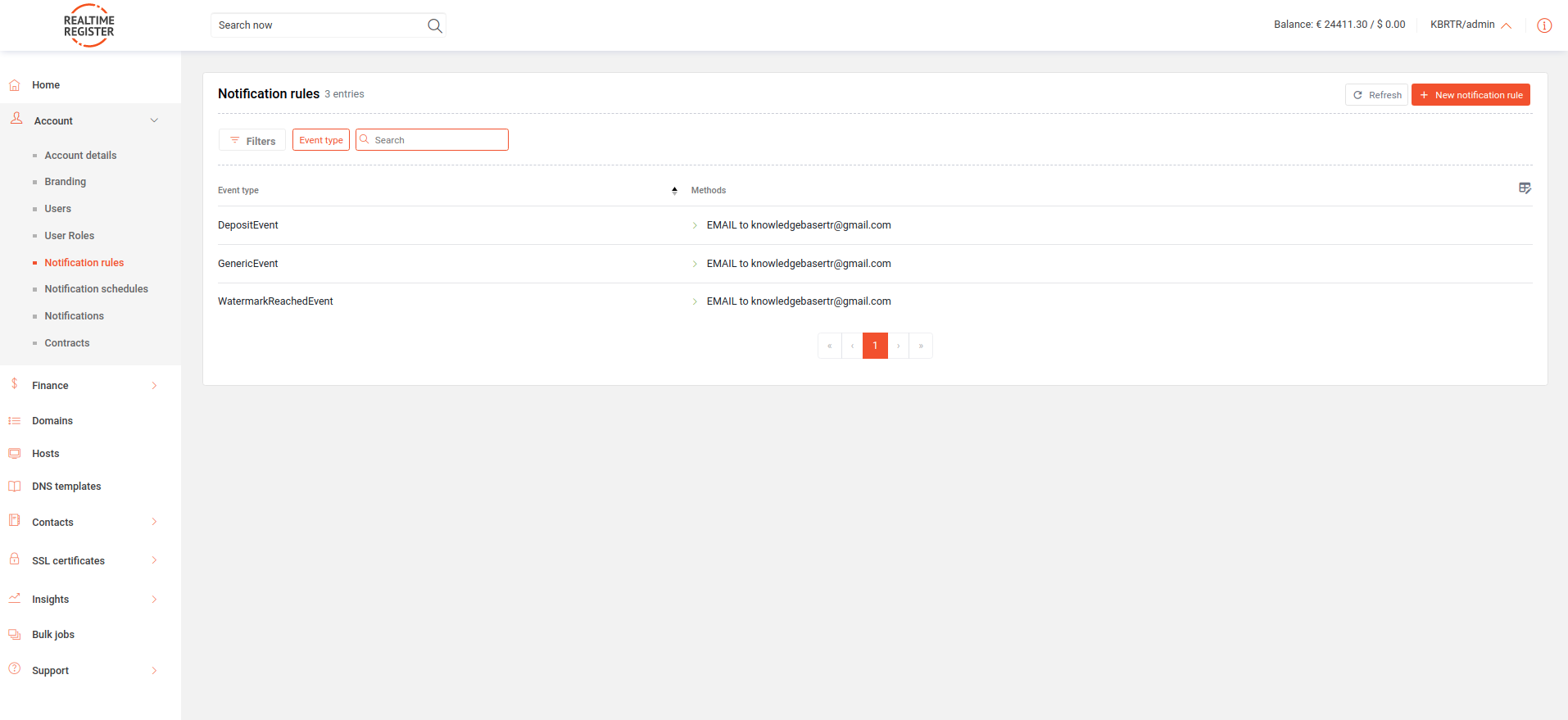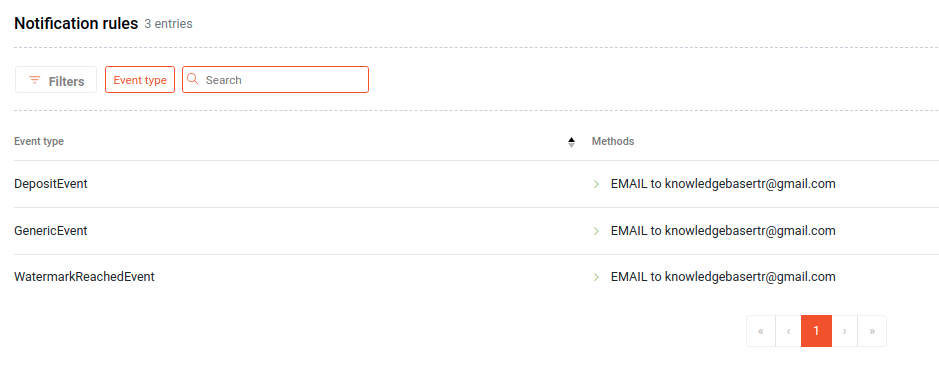Notification Rules
Login to the Domain Manager and go to Account details > Notification rules
A notification rule is a set of rules to determine in which way and to which user notifications are being sent. You can fine-tune the information flow for your account to optimize your account and domain management. The image below details the rules which are set up by default when an account has just been created.

There are two columns available to be shown on the notification rule page.

The following events will trigger a notification
BrandEvent
- CreateBrandEvent
- UpdateBrandEvent
ContactEvent
- AddContactRegistryPropertiesEvent
- CreateContactEvent
- SplitContactEvent
- UpdateContactEvent
- UpdateContactRegistryPropertiesEvent
- ValidateContactEvent
CustomerEvent
- UpdateCustomerEvent
DTSDomainStatusChangedEvent
Provides notifications from DTS (Domain Transfer Service) status updates
DnsZoneEvent
- CreateTemplateEvent
- CreateZoneEvent
- DnsZoneKeyRolloverEvent
- UpdateTemplateEvent
- UpdateZoneEvent
DomainEvent
- AbuseDomainEvent
- PastAbuseDomainEvent
- AutoDeleteDomainEvent
- AutoDeleteDomainFailedEvent
- AutoRenewDomainFailedEvent
- AutoUpdateDomainEvent
- CreateDomainEvent
- DeleteDomainEvent
- DomainExpiryReportEvent
- RenewDomainEvent
- RestoreDomainEvent
- SyncDomainEvent
- TransferDomainEvent
- UpdateDomainEvent
FinancialEvent
- ChargeCustomerEvent
- DepositEvent
- NegativeBalanceEvent
- NegativeBalanceGrantedEvent
- PriceEvent
- PremiumDomainChangePriceEvent
- RefundBillableEvent
- WatermarkReachedEvent
HostEvent
- CreateHostEvent
- DeleteHostEvent
- SyncHostEvent
- UpdateHostEvent
IcannRDEDepositEvent
Sent when an RDE deposit has been made (gateway only)
NotificationReportEvent
Sent when a notification report is sent
NotifySalesEvent
Sent when our sales department is notified by a process in your account that requires their attention
NotifySupportEvent
Sent when our support department is notified by a process in your account that requires their attention
ProviderEvent
- ProviderBalanceEvent
- RegistryNotifyEvent
SSLCertificateEvent
- RequestCertificateEvent
- RevokeCertificateEvent
- SSLCertificateExpiryReportEvent
SiteLockEvent
- CreateSiteLockSiteEvent
- DeleteSiteLockSiteEvent
- RenewSiteLockSiteEvent
- RenewSiteLockSiteFailedEvent
- SiteLockSiteRenewalReportEvent
- UpdateSiteLockSiteEvent
UserEvent
- CreateUserEvent
- UpdateUserEvent
- UserPasswordResetEvent
| Create a notification rule |
Update a notification rule |
Delete a notification rule |
Add a new notification rule
Adding new notification rules is not a very complicated process. Follow the instructions below and you should be just fine. In case you do have questions, use the contact form to get in touch with support.
- Click on Add notification rule to add a rule.

- Open the dropdown menu and pick the event you want to create a rule for. In the below example "ContactEvent" is highlighted.
Take note: If you create a rule for this event, all the notifications that are subordinate to the Contact Event will be sent by this notification rule. If you only, for example, want to get informed when a contacthandle is validated, you select the subordinate "ValidateContactEvent" and this rule will only trigger on the subordinate, not both subordinates which are categorized as a ContactEvent. This goes for all event types and their subordinates.

- Next, you're going to select the methods and recipients. Queue gives output through API, Email sends an automated email to the selected recipient. You can use both or one of the two options. Once determined which methods will be used for your rule, submit the recipients/click the queue checkbox and click create notification rule button

- You've now successfully created a notification rule.
Changing existing notification rules
Changing existing notification rules is not a very complicated process, it's pretty much the same as creating a new one. Follow the instructions below and you should be just fine. In case you do have questions, use the contact form to get in touch with support.
- Changing an existing notification rule can be done by clicking the three dots on the right behind the rule you wish to update. Then click update in the dropdown to proceed to the update screen.

- Once opened, you'll be able to adjust the preferences. Just select the Methods and Recipients you need for your specific situation and click the update button.

- You've now successfully updated a notification rule.
Delete a notification rule
- To delete a notification rule, simply click the three dots in line with the notification rule you wish to delete and hit 'delete'

- Click the Delete notification rule button to confirm the deletion.

- You've now successfully deleted a notification rule
